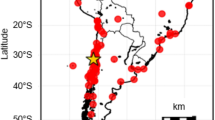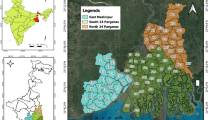Abstract
The Xinmo landslide occurred in the early morning of 24 June 2017 at about 5:38 am local time. This catastrophic event caused enormous casualties and huge economic losses in Xinmo Village, Mao County, Sichuan Province, China. In this study, Synthetic Aperture Radar (SAR) datasets acquired by X-band TerraSAR-X, Phased Array type L-band Synthetic Aperture Radar-2 (PALSAR-2) aboard the Advanced Land Observing Satellite-2 (ALOS-2), and C-band Sentinel-1 over the disaster area were collected and analyzed to characterize this landslide. The high-resolution TerraSAR-X intensity images were used to evaluate the landslide disaster and delineate the sliding area. Afterwards, two ALOS-2 PALSAR-2 image pairs and a stack of 45 Sentinel-1 images were processed to detect precursory movements of the landslide surface, using the conventional differential InSAR (DInSAR) method and advanced time series InSAR analysis. The unstable source area near the ridge was identified from the displacement rate map derived from Sentinel-1 datasets. The maximum displacement rate detected at the source area was −35mm/year along the radar line of sight (LOS) direction. The time series of LOS displacements over 2 years presents an easily discerned seasonal evolution pattern. In particular, a sudden acceleration of the displacement, dozens of days before the collapse was clearly captured by the Sentinel-1 observations, which might suggest that early warning of landslide disasters is possible given the availability of operational SAR data acquired in frequent repeat-pass mode, such as the Sentinel-1 twin-satellite constellation.









Similar content being viewed by others
References
Bamler R, Hartl P (1998) Synthetic aperture radar interferometry. Inverse Problems 14:R1
Bianchini S, Cigna F, Righini G, Proietti C, Casagli N (2012) Landslide hotspot mapping by means of persistent scatterer interferometry. Environmental Earth Sciences 67:1155–1172. https://doi.org/10.1007/s12665-012-1559-5
Bianchini S, Herrera G, Mateos R, Notti D, Garcia I, Mora O, Moretti S (2013) Landslide activity maps generation by means of persistent scatterer interferometry. Remote Sens 5:6198
Bonì R, Herrera G, Meisina C, Notti D, Béjar-Pizarro M, Zucca F, González PJ, Palano M, Tomás R, Fernández J, Fernández-Merodo JA, Mulas J, Aragón R, Guardiola-Albert C, Mora O (2015) Twenty-year advanced DInSAR analysis of severe land subsidence: the Alto Guadalentín Basin (Spain) case study. Eng Geol 198:40–52. https://doi.org/10.1016/j.enggeo.2015.08.014
Cascini L, Fornaro G, Peduto D (2010) Advanced low- and full-resolution DInSAR map generation for slow-moving landslide analysis at different scales. Eng Geol 112:29–42. https://doi.org/10.1016/j.enggeo.2010.01.003
Chai H, Liu H, Zhang Z (1995) Landslide dams induced by Diexi earthquake in 1933 and its environmental effect. Journal of Geological Hazards and Environment Preservation 6:7–17
Chang L (1938) Investigation report on Diexi earthquake of Sichuan. Geological Review 3:251–293
CUHK-ISEIS (2017) CUHK-ISEIS analyzes “6.24” landslide in Maoxian. In: Sichuan Province with satellite images http://www.cpr.cuhk.edu.hk/en/press_detail.php?id=2544
Cigna F, Bianchini S, Casagli N (2013) How to assess landslide activity and intensity with persistent scatterer interferometry (PSI): the PSI-based matrix approach. Landslides 10:267–283. https://doi.org/10.1007/s10346-012-0335-7
Colesanti C, Wasowski J (2006) Investigating landslides with space-borne synthetic aperture radar (SAR) interferometry. Eng Geol 88:173–199
Farina P, Colombo D, Fumagalli A, Marks F, Moretti S (2006) Permanent scatterers for landslide investigations: outcomes from the ESA-SLAM project. Eng Geol 88:200–217
Ferretti A, Prati C, Rocca F (2000) Nonlinear subsidence rate estimation using permanent scatterers in differential SAR interferometry. Geoscience and Remote Sensing, IEEE Transactions on 38:2202–2212
García-Davalillo JC, Herrera G, Notti D, Strozzi T, Álvarez-Fernández I (2014) DInSAR analysis of ALOS PALSAR images for the assessment of very slow landslides: the Tena Valley case study. Landslides 11:225–246. https://doi.org/10.1007/s10346-012-0379-8
Ge L, Ng AH-M, Li X, Abidin HZ, Gumilar I (2014) Land subsidence characteristics of Bandung basin as revealed by ENVISAT ASAR and ALOS PALSAR interferometry. Remote Sens Environ 154:46–60. https://doi.org/10.1016/j.rse.2014.08.004
Guzzetti F, Manunta M, Ardizzone F, Pepe A, Cardinali M, Zeni G, Reichenbach P, Lanari R (2009) Analysis of ground deformation detected using the SBAS-DInSAR technique in Umbria, central Italy. Pure Appl Geophys 166:1425–1459. https://doi.org/10.1007/s00024-009-0491-4
Herrera G, Gutiérrez F, García-Davalillo JC, Guerrero J, Notti D, Galve JP, Fernández-Merodo JA, Cooksley G (2013) Multi-sensor advanced DInSAR monitoring of very slow landslides: the Tena valley case study (central Spanish Pyrenees). Remote Sens Environ 128:31–43. https://doi.org/10.1016/j.rse.2012.09.020
Hilley GE, Bürgmann R, Ferretti A, Novali F, Rocca F (2004) Dynamics of slow-moving landslides from permanent scatterer analysis. Science 304:1952–1955
Hooper A (2008) A multi-temporal InSAR method incorporating both persistent scatterer and small baseline approaches. Geophys Res Lett 35
Hu X, Wang T, Pierson TC, Lu Z, Kim J, Cecere TH (2016) Detecting seasonal landslide movement within the cascade landslide complex (Washington) using time-series SAR imagery. Remote Sens Environ 187:49–61. https://doi.org/10.1016/j.rse.2016.10.006
Jones L, Han W, Hauksson E, Jin A, Zhang Y, Luo Z (1984) Focal mechanisms and aftershock locations of the Songpan earthquakes of August 1976 in Sichuan, China. Journal of Geophysical Research Solid Earth 89(B9):7697–7707. https://doi.org/10.1029/jb089ib09p07697
Kampes BM, Hanssen RF, Perski Z (2003) Radar interferometry with public domain tools. Proceedings of FRINGE
Lu Z, Dzurisin D (2014) InSAR imaging of Aleutian volcanoes: monitoring a volcanic arc from space. Springer Praxis Books 2014:1778–1786
Massonnet D, Feigl KL (1998) Radar interferometry and its application to changes in the earth's surface. Rev Geophys 36:441–500
Massonnet D, Rossi M, Carmona C, Adragna F, Peltzer G, Feigl K, Rabaute T (1993) The displacement field of the landers earthquake mapped by radar interferometry. Nature 364:138–142
Meisina C, Zucca F, Fossati D, Ceriani M, Allievi J (2006) Ground deformation monitoring by using the permanent scatterers technique: the example of the Oltrepo Pavese (Lombardia, Italy). Eng Geol 88:240–259. https://doi.org/10.1016/j.enggeo.2006.09.010
Moretto S, Bozzano F, Esposito C, Mazzanti P, Rocca A (2017) Assessment of landslide pre-failure monitoring and forecasting using satellite SAR interferometry. Geosciences 7:36
NERC-COMET (2017) Sentinel-1 satellites reveal pre-event movements and source areas of the Maoxian landslides. In: China http://comet.nerc.ac.uk/sentinel-1-satellites-reveal-pre-event-movements-source-areas-maoxian-landslides-china/
Ng AH-M, Ge L, Li X (2015) Assessments of land subsidence in the Gippsland Basin of australia using ALOS PALSAR data. Remote Sens Environ 159:86–101. https://doi.org/10.1016/j.rse.2014.12.003
Notti D, Davalillo JC, Herrera G, Mora O (2010) Assessment of the performance of X-band satellite radar data for landslide mapping and monitoring: Upper Tena Valley case study. Natural Hazards & Earth System Sciences 10:1865–1875
Oliver C, Quegan S (2004) Understanding synthetic aperture radar images. SciTech Publishing
Shi X, Liao M, Li M, Zhang L, Cunningham C (2016) Wide-area landslide deformation mapping with multi-path ALOS PALSAR data stacks: a case study of three gorges area, China. Remote Sens 8:136
Shi X, Zhang L, Tang M, Li M, Liao M (2017) Investigating a reservoir bank slope displacement history with multi-frequency satellite SAR data. Landslides:1–13. https://doi.org/10.1007/s10346-017-0846-3
Simons M, Rosen PA (2007) 3.12—interferometric synthetic aperture radar geodesy a2—Schubert, Gerald. Treatise on geophysics. Elsevier, Amsterdam, pp 391–446
SKLGP (2017) Bulletin of Xinmo landslide in Mao County. State Key Laboratory of Geohazard Prevention and Geoenvironment Protection (SKLGP), Chengdu University of Technology, Chengdu, China
Stumpf A, Malet J-P, Delacourt C (2017) Correlation of satellite image time-series for the detection and monitoring of slow-moving landslides. Remote Sens Environ 189:40–55. https://doi.org/10.1016/j.rse.2016.11.007
Su L, Hu K, Zhang W, Wang J, Lei Y, Zhang C, Cui P, Pasuto A, Zheng Q (2017) Characteristics and triggering mechanism of Xinmo landslide on 24 June 2017 in Sichuan, China. J Mt Sci 14(9):1689–1700. https://doi.org/10.1007/s11629-017-4609-3
TRE-ALTAMIRA (2017) Data in focus: precursor of Maoxian landslide measured from space. http://tre-altamira.com/news/data-focus-precursor-maoxian-landslide-measured-space/
Wasowski J, Bovenga F (2014) Investigating landslides and unstable slopes with satellite multi temporal interferometry: current issues and future perspectives. Eng Geol 174:103–138
Yin Y, Wang F, Sun P (2009) Landslide hazards triggered by the 2008 Wenchuan earthquake, Sichuan, China. Landslides 6:139–152. https://doi.org/10.1007/s10346-009-0148-5
Yin Y, Zheng W, Liu YL, Zhang J, Li X (2010) Integration of GPS with InSAR to monitoring of the Jiaju landslide in Sichuan, China. Landslides 7:359–365
Zhang Y, Meng X, Chen G, Qiao L, Zeng R, Chang J (2016) Detection of geohazards in the Bailong River basin using synthetic aperture radar interferometry. Landslides 13:1273–1284. https://doi.org/10.1007/s10346-015-0660-8
Zhao C, Lu Z, Zhang Q, de la Fuente J (2012) Large-area landslide detection and monitoring with ALOS/PALSAR imagery data over northern California and southern Oregon, USA. Remote Sens Environ 124:348–359. https://doi.org/10.1016/j.rse.2012.05.025
Acknowledgements
Helpful suggestions and comments given by Dr. Teng Wang with Earth Observatory of Singapore, Dr. Xuguo Shi with China University of Geoscience (Wuhan), and Prof. Qiang Xu with Chengdu University of Technology are appreciated. The ALOS-2 PALSAR-2 datasets are provided by Japan Aerospace Exploration Agency (JAXA) through the ALOS-RA project (PI1247, PI1440, and PI3248). The Sentinel-1 datasets are provided by the European Space Agency (ESA) under the Dragon 4 project (id 32278). The TerraSAR-X datasets are provided by German Aerospace Center (DLR) and EADS Astrium. We thank Stephen C. McClure for providing assistance in language editing.
Funding
This work was financially supported by the National Key R&D Program of China (Grant No. 2017YFB0502700), the National Key Basic Research Program of China (Grant Nos. 2013CB733205 and 2013CB733204), and the National Natural Science Foundation of China (Grant Nos. 61331016, 41774006 and 41571435).
Author information
Authors and Affiliations
Corresponding author
Rights and permissions
About this article
Cite this article
Dong, J., Zhang, L., Li, M. et al. Measuring precursory movements of the recent Xinmo landslide in Mao County, China with Sentinel-1 and ALOS-2 PALSAR-2 datasets. Landslides 15, 135–144 (2018). https://doi.org/10.1007/s10346-017-0914-8
Received:
Accepted:
Published:
Issue Date:
DOI: https://doi.org/10.1007/s10346-017-0914-8




